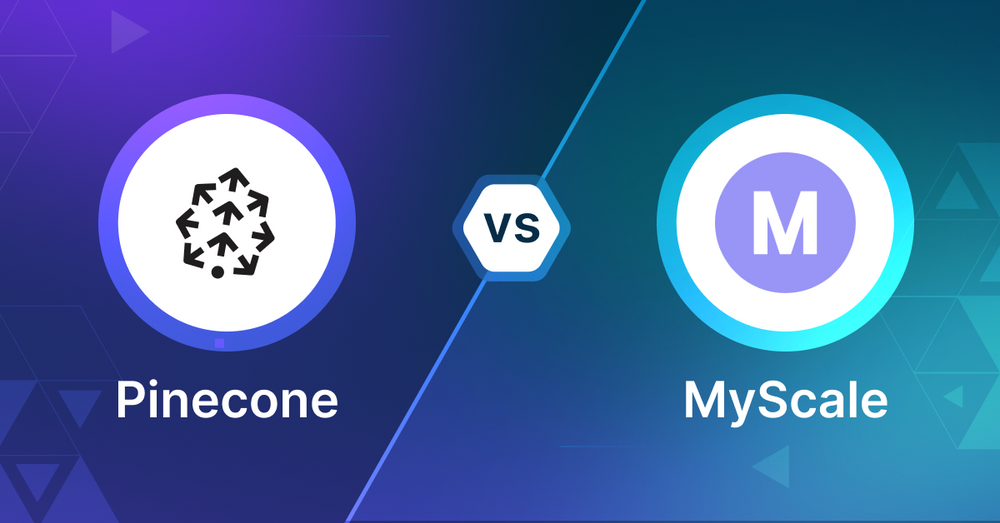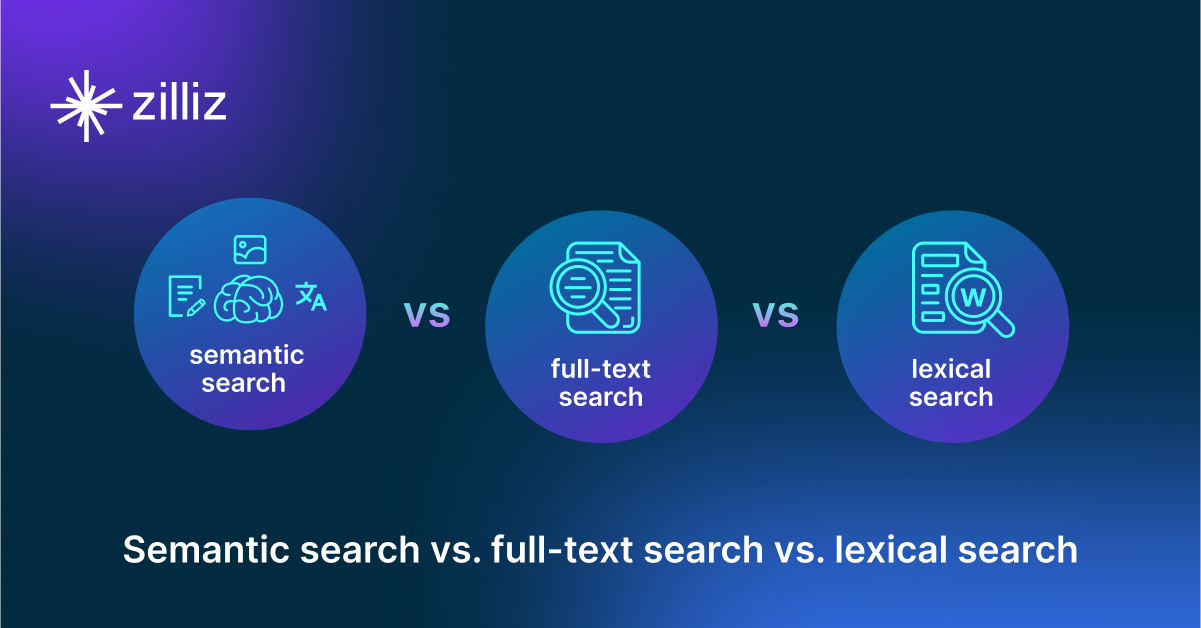Pinecone vs Myscale: Selecting the Right Database for GenAI Applications

As AI-driven applications evolve, the importance of vector search capabilities in supporting these advancements cannot be overstated. This blog post will discuss two prominent databases with vector search capabilities: Pinecone and Myscale. Each provides robust capabilities for handling vector search, an essential feature for applications such as recommendation engines, image retrieval, and semantic search. Our goal is to provide developers and engineers with a clear comparison, aiding in the decision of which database best aligns with their specific requirements.
What is a Vector Database?
Before we compare Pinecone vs Myscale, let's first explore the concept of vector databases.
A vector database is specifically designed to store and query high-dimensional vectors, which are numerical representations of unstructured data. These vectors encode complex information, such as the semantic meaning of text, the visual features of images, or product attributes. By enabling efficient similarity searches, vector databases play a pivotal role in AI applications, allowing for more advanced data analysis and retrieval.
Common use cases for vector databases include e-commerce product recommendations, content discovery platforms, anomaly detection in cybersecurity, medical image analysis, and natural language processing (NLP) tasks. They also play a crucial role in Retrieval Augmented Generation (RAG), a technique that enhances the performance of large language models (LLMs) by providing external knowledge to reduce issues like AI hallucinations.
There are many types of vector databases available in the market, including:
- Purpose-built vector databases such as Milvus, Zilliz Cloud (fully managed Milvus)
- Vector search libraries such as Faiss and Annoy.
- Lightweight vector databases such as Chroma and Milvus Lite.
- Traditional databases with vector search add-ons capable of performing small-scale vector searches.
Pinecone is a purpose-built vector database and MyScale is a database built on ClickHouse that combines vector search and SQL analytics. This post compares their vector search capabilities.
Pinecone: The Basics
Pinecone is a SaaS built for vector search in machine learning applications. As a managed service, Pinecone handles the infrastructure so you can focus on building applications not databases. It’s a scalable platform for storing and querying large amounts of vector embeddings for tasks like semantic search and recommendation systems.
Key features of Pinecone include real-time updates, machine learning model compatibility and a proprietary indexing technique that makes vector search fast even with billions of vectors. Namespaces allow you to divide records within an index for faster queries and multitenancy. Pinecone also supports metadata filtering, so you can add context to each record and filter search results for speed and relevance.
Pinecone’s serverless offering makes database management easy and includes efficient data ingestion methods. One of the features is the ability to import data from object storage, which is very cost effective for large scale data ingestion. This uses an asynchronous long running operation to import and index data stored as Parquet files.
To improve search Pinecone hosts the multilanguage-e5-large model for vector generation and has a two stage retrieval process with reranking using the bge-reranker-v2-m3 model. Pinecone also supports hybrid search which combines dense and sparse vector embeddings to balance semantic understanding with keyword matching. With integration into popular machine learning frameworks, multiple language support and auto scaling Pinecone is a complete solution for vector search in AI applications with both performance and ease of use.
What is MyScale? The Basics
MyScale is a cloud based database built on top of the open source ClickHouse database, designed for AI and machine learning workloads. It can handle structured and vector data and real time analytics and machine learning. MyScale is focused on time series, vector search and full text search so it’s good for real time processing and AI driven insights. By using ClickHouse architecture, MyScale is high performance and scalable for AI.
One of the key features of MyScale is native SQL support which simplifies AI driven queries by integrating vector search, full text search and traditional SQL queries in one system. This reduces the need for multiple tools and makes it scalable for AI. MyScale supports and manages analytical processing of both structured and vectorized data on one platform using OLAP database architecture to operate on vectorized data. Developers can interact with MyScale using SQL so it’s accessible to all programmers familiar with relational databases.
MyScale has multiple vector index types and similarity metrics to support different use cases. It supports common distance metrics like Euclidean distance (L2), inner product (IP) and cosine similarity. The database has multiple indexing algorithms: MSTG (Multi-Scale Tree Graph), ScaNN, IVFFLAT, IVFPQ, IVFSQ and HNSW, each with its own set of parameters to tune. MyScale’s proprietary MSTG vector engine uses NVMe SSDs to increase data density so it outperforms specialized vector databases in both performance and cost.
By combining the functionality of an SQL database, vector database and full text search engine into one system MyScale reduces infrastructure and maintenance costs. This unification allows for joint data queries and analytics and a single data foundation for AI applications. MyScale also has MyScale Telemetry for full observability of LLM systems so you can monitor and debug efficiently. As data gets more complex MyScale is a future proof solution that can handle newer data modalities and database sizes while keeping computing performance and integration between different data types.
Key Differences
When choosing a vector search tool, developers and engineers need to consider many things. Let’s compare Pinecone and MyScale across key areas to help you pick the right one for your project.
Search Methodology
Pinecone has a proprietary indexing technique for fast vector search even with billions of vectors. It supports real-time updates and two-stage retrieval with reranking.
MyScale built on ClickHouse has multiple vector index types and similarity metrics. It supports common distance metrics like Euclidean distance, inner product and cosine similarity. MyScale has multiple indexing algorithms: MSTG, ScaNN, IVFFLAT, IVFPQ, IVFSQ, HNSW.
Data
Pinecone is focused on vector embeddings and supports metadata filtering. You can add context to each record and filter search results.
MyScale handles both structured and vector data, time series, vector search and full-text search. It can process both structured and vectorized data on a single platform using OLAP database architecture.
Scalability and Performance
Pinecone is auto-scaling and designed for large scale vector search. Its serverless offering simplifies database management.
MyScale uses ClickHouse architecture for high performance and scalability. Its proprietary MSTG vector engine uses NVMe SSDs to increase data density and potentially outperforms specialized vector databases in both performance and cost.
Flexibility and Customization
Pinecone has namespaces to divide records within an index for faster queries and multitenancy. It supports hybrid search, dense and sparse vector embeddings.
MyScale has flexibility through multiple vector index types and similarity metrics. Users can tune the indexing algorithms to their use case.
Integration and Ecosystem
Pinecone integrates with popular ML frameworks and multiple programming languages.
MyScale is a SQL database, vector database and full-text search engine in one system. This unified approach allows joint data queries and analytics.
Ease of Use
Pinecone is a managed service that takes care of the infrastructure, so you can focus on building your application. It has efficient data ingestion methods, including importing data from object storage.
MyScale is native SQL so it’s accessible to programmers familiar with relational databases. This can simplify AI-driven queries by having vector search, full-text search and traditional SQL queries in one system.
Cost
Pinecone’s serverless offering and efficient data ingestion methods can help with cost. Importing data from object storage can be cost effective for large scale data ingestion.
MyScale’s unified approach can reduce infrastructure and maintenance costs by having multiple functionality in one system. Its MSTG vector engine claims to outperform and be more cost effective than specialized vector databases.
Read this to get an overview of Pinecone and Myscale but to evaluate these you need to evaluate based on your use case. One tool that can help with that is VectorDBBench, an open-source benchmarking tool for vector database comparison. In the end, thorough benchmarking with your own datasets and query patterns will be key to making a decision between these two powerful but different approaches to vector search in distributed database systems.
Using Open-source VectorDBBench to Evaluate and Compare Vector Databases on Your Own
VectorDBBench is an open-source benchmarking tool for users who need high-performance data storage and retrieval systems, especially vector databases. This tool allows users to test and compare different vector database systems like Milvus and Zilliz Cloud (the managed Milvus) using their own datasets and find the one that fits their use cases. With VectorDBBench, users can make decisions based on actual vector database performance rather than marketing claims or hearsay.
VectorDBBench is written in Python and licensed under the MIT open-source license, meaning anyone can freely use, modify, and distribute it. The tool is actively maintained by a community of developers committed to improving its features and performance.
Download VectorDBBench from its GitHub repository to reproduce our benchmark results or obtain performance results on your own datasets.
Take a quick look at the performance of mainstream vector databases on the VectorDBBench Leaderboard.
Read the following blogs to learn more about vector database evaluation.
Further Resources about VectorDB, GenAI, and ML
- What is a Vector Database?
- Pinecone: The Basics
- What is MyScale? The Basics
- Key Differences
- Using Open-source VectorDBBench to Evaluate and Compare Vector Databases on Your Own
- Further Resources about VectorDB, GenAI, and ML
Content
Start Free, Scale Easily
Try the fully-managed vector database built for your GenAI applications.
Try Zilliz Cloud for FreeKeep Reading

Optimizing Embedding Model Selection with TDA Clustering: A Strategic Guide for Vector Databases
Discover how Topological Data Analysis (TDA) reveals hidden embedding model weaknesses and helps optimize vector database performance.

Bringing AI to Legal Tech: The Role of Vector Databases in Enhancing LLM Guardrails
Discover how vector databases enhance AI reliability in legal tech, ensuring accurate, compliant, and trustworthy AI-powered legal solutions.

Semantic Search vs. Lexical Search vs. Full-text Search
Lexical search offers exact term matching; full-text search allows for fuzzy matching; semantic search understands context and intent.
The Definitive Guide to Choosing a Vector Database
Overwhelmed by all the options? Learn key features to look for & how to evaluate with your own data. Choose with confidence.